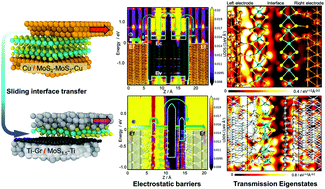Our official English website, www.x-mol.net, welcomes your feedback! (Note: you will need to create a separate account there.)
Achieving a superlubricating ohmic sliding electrical contact via a 2D heterointerface: a computational investigation
Nanoscale ( IF 6.7 ) Pub Date : 2020/03/11 , DOI: 10.1039/c9nr09662k Aisheng Song 1, 2, 3, 4 , Lei Gao 4, 5, 6, 7, 8 , Jie Zhang 1, 2, 3, 4 , Xiao Liu 1, 2, 3, 4 , Yuan-Zhong Hu 1, 2, 3, 4 , Tian-Bao Ma 1, 2, 3, 4 , Quanshui Zheng 1, 2, 3, 4, 9 , Jianbin Luo 1, 2, 3, 4
Nanoscale ( IF 6.7 ) Pub Date : 2020/03/11 , DOI: 10.1039/c9nr09662k Aisheng Song 1, 2, 3, 4 , Lei Gao 4, 5, 6, 7, 8 , Jie Zhang 1, 2, 3, 4 , Xiao Liu 1, 2, 3, 4 , Yuan-Zhong Hu 1, 2, 3, 4 , Tian-Bao Ma 1, 2, 3, 4 , Quanshui Zheng 1, 2, 3, 4, 9 , Jianbin Luo 1, 2, 3, 4
Affiliation

|
Simultaneously achieving low friction and fine electrical conductance of sliding electrical contacts is a crucial factor but a great challenge for designing high-performance microscale and nanoscale functional devices. Through atomistic simulations, we propose an effective design strategy to obtain both low friction and high conductivity in sliding electrical contacts. By constructing graphene(Gr)/MoS2 two-dimensional (2D) heterojunctions between sliding Cu surfaces, superlubricity can be achieved with a remarkably lowered sliding energy barrier as compared to that of the homogeneous MoS2 lubricated Cu contact. Moreover, by introducing vacancy defects into MoS2 and substituting Cu with active metal Ti, the Schottky and tunneling barriers can be substantially suppressed without losing the superlubricious properties of the tribointerface. Consequently, a high conductivity ohmic contact with low sliding friction could be realized in our proposed Ti–MoS1.5–Gr–Ti system, which provides a potential strategy for tackling the well-known dilemma for high performance sliding electrical contacts.
中文翻译:

通过2D异质接口实现超润滑欧姆滑动电接触:计算研究
同时实现滑动电触点的低摩擦和良好的电导率是至关重要的因素,但对于设计高性能的微米级和纳米级功能器件来说却是一个巨大的挑战。通过原子模拟,我们提出了一种有效的设计策略,可以在滑动电触点中获得低摩擦和高导电率。通过在滑动的Cu表面之间构建石墨烯(Gr)/ MoS 2二维(2D)异质结,与均匀的MoS 2润滑的Cu接触相比,可通过显着降低的滑动能垒实现超润滑。此外,通过将空位缺陷引入MoS 2并且用活性金属Ti代替Cu,可以在不损失摩擦界面的超润滑性能的情况下基本抑制肖特基和隧穿势垒。因此,在我们提出的Ti-MoS 1.5 -Gr-Ti系统中,可以实现具有低滑动摩擦的高导电性欧姆接触,这为解决众所周知的高性能滑动电接触难题提供了潜在的策略。
更新日期:2020-04-09
中文翻译:

通过2D异质接口实现超润滑欧姆滑动电接触:计算研究
同时实现滑动电触点的低摩擦和良好的电导率是至关重要的因素,但对于设计高性能的微米级和纳米级功能器件来说却是一个巨大的挑战。通过原子模拟,我们提出了一种有效的设计策略,可以在滑动电触点中获得低摩擦和高导电率。通过在滑动的Cu表面之间构建石墨烯(Gr)/ MoS 2二维(2D)异质结,与均匀的MoS 2润滑的Cu接触相比,可通过显着降低的滑动能垒实现超润滑。此外,通过将空位缺陷引入MoS 2并且用活性金属Ti代替Cu,可以在不损失摩擦界面的超润滑性能的情况下基本抑制肖特基和隧穿势垒。因此,在我们提出的Ti-MoS 1.5 -Gr-Ti系统中,可以实现具有低滑动摩擦的高导电性欧姆接触,这为解决众所周知的高性能滑动电接触难题提供了潜在的策略。



























 京公网安备 11010802027423号
京公网安备 11010802027423号